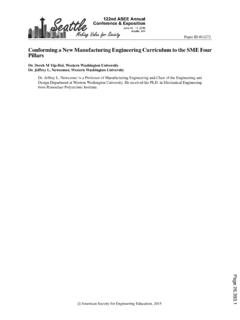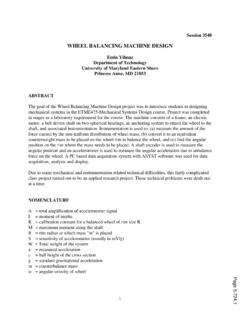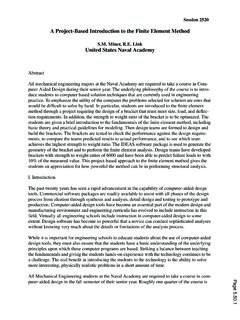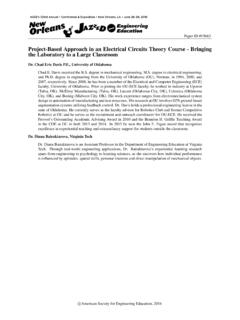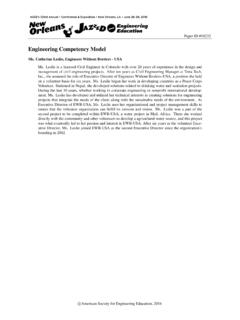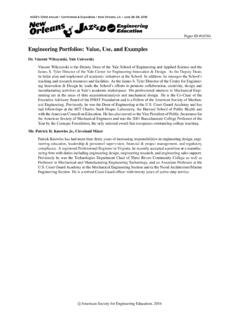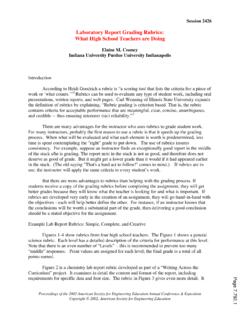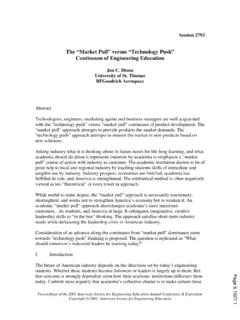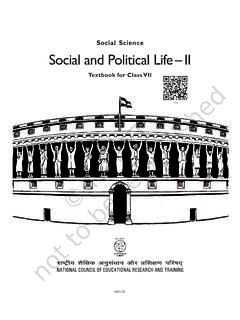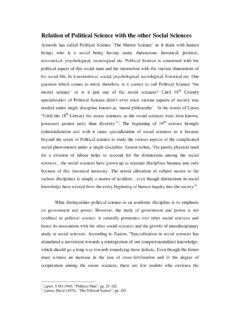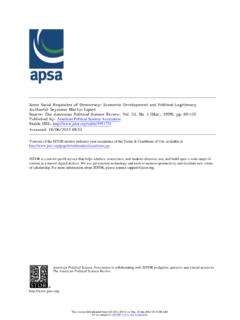Transcription of The Social, Economic, And Political Impact Of Technology ...
1 AC 2010-1015: THE social , ECONOMIC, AND Political Impact OFTECHNOLOGY: AN HISTORICAL PERSPECTIVEW illiam Loendorf, Eastern Washington UniversityWilliam R. Loendorf is currently an Associate Professor of Engineering & Design at EasternWashington University. He obtained his in Engineering Science at the University ofWisconsin - Parkside, in Electrical Engineering at Colorado State University, at theLake Forest Graduate School of Management, and in Engineering Management at WaldenUniversity. He holds a Professional Engineer license and has 30 years of industrial experience asan Engineer or Engineering Manager at General Motors, Cadnetix, and Motorola.
2 His interestsinclude engineering management, technological literacy, and real-time embedded systems. American Society for Engineering Education, 2010 Page The social , Economic, and Political Impact of Technology : An Historical Perspective Abstract Our modern lives are filled with technologies. In fact, they have become so integrated into our lives that many of them are frequently used but never really thought about. Few people stop to consider that civilization once lived on without them. Many of these technologies are so common today that they have become almost invisible. The Impact of Technology on our lives is substantial, even though it may not be obvious, understood, or even considered.
3 For many, it is simply accepted. Technologies have changed the way people live, work, and play. However, this is not a new phenomenon. Technology has changed civilization in many ways throughout all of history. Today, few people stop to consider the social , economic, and Political Impact Technology has had on our lives. To address this issue, an interdisciplinary junior level course has been created that explores a historical perspective of the development of Technology in a global context. The social , Political , economic and cultural impacts of technologies are explored to determine their positive and negative effects. In this context the two biggest Technology drivers of agriculture and war are studied in detail.
4 Through innovations agriculture was able to produce more food allowing populations to grow. While new inventions created more effective and devastating weapons of war used to kill and destroy. Throughout the course, numerous technologies are scrutinized and examined in terms of their cost versus benefit to society. It also investigates how technologies are inter-related and how cultural factors affect the acceptance or rejection of Technology . The intent of the course was to enhance the student s understanding of how technologies developed and why. The material covered helps the student to understand and recognize our dependence on Technology and its Impact on our lives.
5 In this course the students study the past development, use and effects of Technology in order to be better prepared for the new technologies of the future. Introduction Throughout history, new inventions and innovations have produced more food, created new tools, made life easier, and war more devastating. Today Technology influences and affects every aspect of our life. However, we often forget that it profoundly affected the lives of past generations dating back to the beginning of civilization. Perhaps not to today s extent, but the Impact was still dramatic. An interdisciplinary course was created a number of years ago (Loendorf5) that explores a historical perspective of the development of Technology in a global context.
6 This junior level course (TECH 393), titled Technology in World Civilization, traces the interconnected events and cultures in which Technology developed. It investigates how technologies are inter-related and how cultural factors affect the acceptance or rejection of Technology . The intent of the course was to enhance the student s understanding of how technologies developed, why they were used, and their Impact on society. This course traces the evolution of Technology and its Impact on Page civilization from the creation of elementary tools up to today s latest devices and even looks into future technologies. Numerous questions or mysteries of the past are addressed.
7 For example, why did similar inventions appear in different parts of the world almost simultaneously? How did information and Technology spread from one place to another and why did they fade away in one place only to resurface later in a different place? How and why were inventions or innovations diffused or borrowed from one culture adapted to suit the needs of another? Teaching methods include lectures, discussions, videos, and written essay projects. The lectures and discussions are designed and intended to be very interactive and engaging for the students. The selected videos show how past technologies were developed and used. The essays require students to identify and apply the knowledge obtained from the course to both historical and today s technologies.
8 The students are challenged to be creative and innovative in their solutions to the problems presented to them. This interdisciplinary course satisfies the University s International Studies graduation requirement. As a result, students from all disciplines across campus regularly take the course leading to a great diversity of backgrounds and specialties. Perhaps this explains the wide spectrum of opinions, comments and ideas expressed both in the class discussions and in the written essays. Objectives The course has two main objectives: (1) promote awareness of technological development, and (2) provide a rudimentary understanding of the social , Political , economic and cultural Impact of Technology .
9 These two main objectives were then expanded to create a more comprehensive list of objectives for the student. Upon completion of the course, a student can: 1. Recount the interconnected events and cultures in which a Technology developed. 2. Describe how technologies are inter-related. 3. Critique technologies based on: system aspects, applied knowledge, specific goals, organizational forms, winners/losers, etc. 4. Describe a world technological problem (weapons, fuel usage, public health, etc.) from both a developing nations and technologically advanced nations viewpoint. 5. Recount the development of major technologies historically. 6. Understand and can cite examples of technological dialog and diffusion.
10 7. Recognize occurrences of technological determinism and social constructivism. 8. Cite examples of cultural factors affecting the acceptance or rejection of a Technology . 9. Discuss issues relating to technological advance and cultural lag. 10. Describe how the convergence theory has affected the world s nations and brought them closer together. 11. Understand the dilemmas relating to halfway technologies. 12. Recognize our dependence on Technology and understand its invasive nature. 13. Understand the use of appropriate (Western) Technology in developing world cultures. 14. Recognize that engineers of previous millenniums were very smart! Page In addition, these objectives were designed to respond to the Accreditation Board for Engineering and Technology1 (ABET) requirements listed in its Engineering Criteria 2000.


